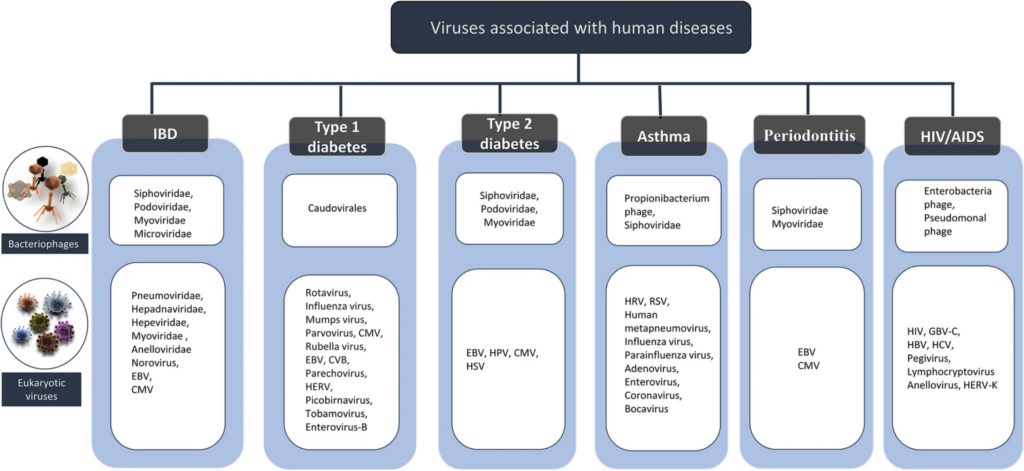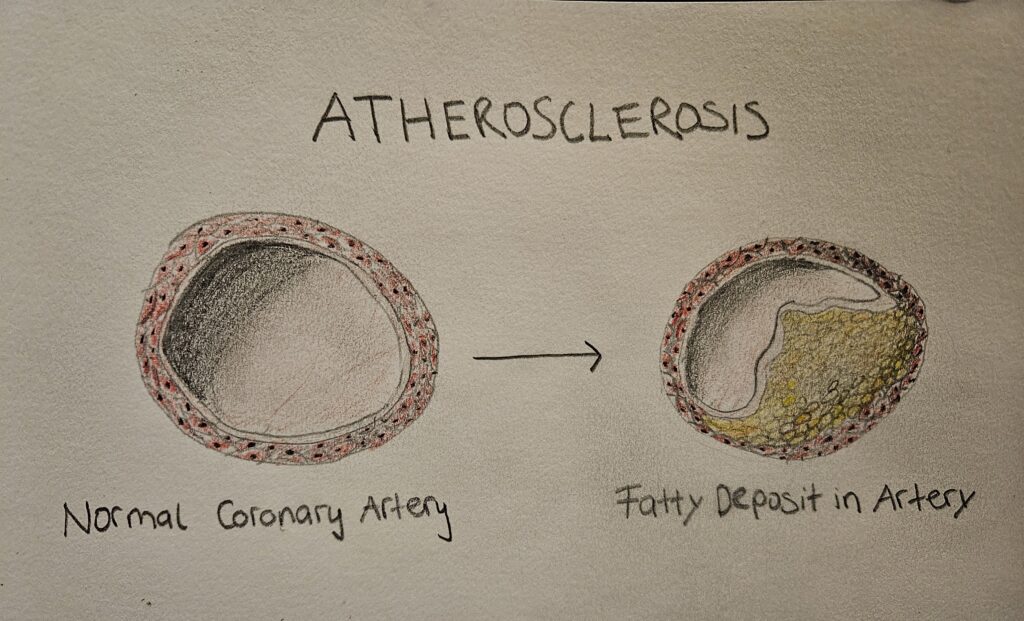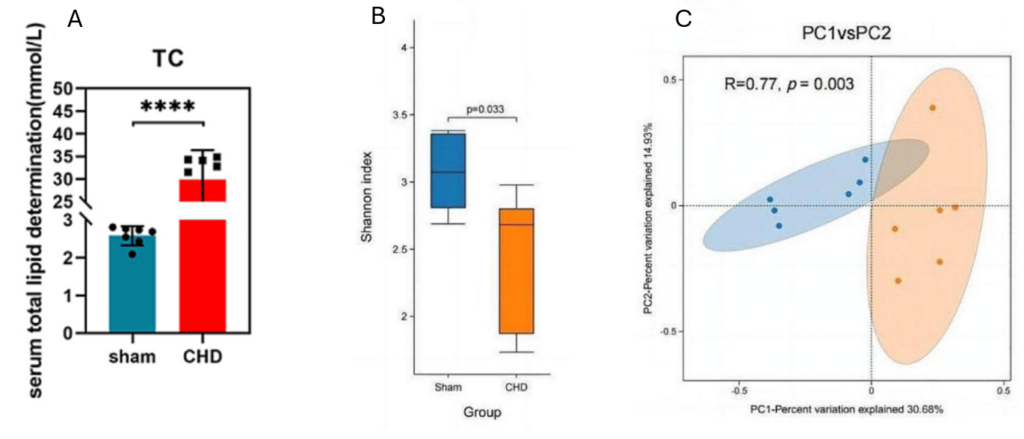Background
Coronary Heart Disease
Coronary heart disease is a major contributor to cardiovascular disease, one of the leading causes of death worldwide (Li et al., 2024). Risk factors for Coronary heart disease include a high-fat diet, smoking, alcohol abuse, and lack of physical activity. Atherosclerosis, involving the buildup of fatty deposits in arteries, is the primary cause of Coronary heart disease (Picture 1). Emerging research suggests that the gut microbiome, consisting of bacteria, viruses, and fungi, may influence cardiovascular health by affecting inflammation and lipid metabolism, both of which contribute to atherosclerosis. However, the precise mechanisms behind this relationship are still being investigated.

The Human Microbiome and Health
The human microbiome is composed of microorganisms such as archaea, bacteria, fungi, microeukaryotes, and viruses that live in and on our bodies. These organisms aid in digestion, vitamin production, and immune support. This diverse community of trillions of microorganisms is present throughout the body, including on the skin, in the respiratory tract, and most notably, in the gut (Athanasopoulou et al., 2023). An imbalance in the gut microbiome can provoke various diseases, including diabetes, certain cancers, allergies, and even neurological disorders (Athanasopoulou et al., 2023).
The Role of Viruses in the Microbiome
Viruses play a critical role in the microbiome, influencing immune responses and interacting with other microbial communities. Eukaryotic viruses (which infect human cells), bacteriophages (which target bacteria), retroviruses (which integrate into host DNA), and giant viruses (large viruses that infect amoebas) are all part of the genetic material within the human body and can have both pathogenic and beneficial effects (Bhagchandani et al., 2024). Figure 1 illustrates potential associations of viruses with human diseases (Bhagchandani et al., 2024). Many of these viruses are harmless and potentially contribute to health by supporting immune regulation. Viruses begin colonizing the gut shortly after birth, with their composition influenced by factors such as diet and age. These viral communities engage with the immune system, significantly impacting health and disease outcomes.
Advances in Microbial Sequencing
With advancements in sequencing technologies like 16S rRNA and whole-genome sequencing, researchers can now identify and study microbes more efficiently and affordably. 16S rRNA sequencing is used to identify and classify bacteria by targeting a specific region of their genetic material, while whole-genome sequencing reads an organism’s entire DNA, providing a complete picture of its genetic makeup.

Central question
Do enteroviruses (referring to viruses in the gut), by interacting with other microbes, influence how the body processes fats and potentially contribute to the development of heart disease, as suggested by Li et al. (2024)?
Evidence
To investigate this relationship, Li et al. (2024) studied gut viruses and metabolites in two groups of mice: one healthy and the other with induced coronary heart disease. They aimed to see if differences in these metabolites—tiny molecules key to energy production—were linked to changes in gut viruses.
Study Design
The unhealthy “experimental” group received a high-fat diet and underwent surgery to block a major artery, simulating heart disease. The healthy “control” group, on a regular diet, had the same surgery without artery blockage to rule out anesthesia effects. After 12 weeks, the mice were euthanized, and fat deposits in the arteries confirmed that the experimental group indeed developed heart disease. The researchers also explored whether specific metabolites increased with certain viruses, suggesting a possible link between them.
Results: Heart Function and Viral Diversity
Heart function was measured using common indicators of how well the left ventricle pumps blood. These measures, along with blood lipid levels, showed significant differences between the two groups, with the experimental group having poorer heart function and much higher Total Cholesterol (TC) (Figure 2A). By measuring alpha diversity, which shows the variety of viruses within each group, Li et al. (2024) discovered that the unhealthy group had significantly lower diversity in enterovirus composition (Figure 2B). They also assessed beta diversity, which looks at differences in viral communities between groups, showing clear distinctions (Figure 2C).

Healthy mice had more viruses like Iridoviridae and Lymphocystivirus, while unhealthy mice had higher levels of Pepyhexavirus and Tsarbombavirus. Tsarbombaviruses infect Bacillus bacteria, which can cause heart conditions like endocarditis and artery stress, potentially linking the virus to heart health. These results suggest a link between heart disease and changes in the gut’s viral community.
Metabolic Shifts in Coronary Heart Disease
The researchers found significant differences in metabolite profiles between the two groups. Pathways related to lipid metabolism were more active in the coronary heart disease group, highlighting a clear metabolic shift, particularly in the arachidonic acid pathway. Arachidonic acid is converted into thromboxane A2, a substance that causes blood vessels to narrow and helps platelets stick together. This process is essential for blood clotting but can also contribute to plaque buildup in arteries (atherosclerosis)—the primary cause of coronary heart disease.
Linking Gut Viruses to Metabolic Pathways
The study revealed that Tsarbombavirus is strongly linked to key metabolites in ether lipid metabolism, crucial for maintaining cell membranes and supporting various bodily functions.
Conclusion
These findings suggest that certain viruses in the gut may play a role in driving changes in metabolism, particularly in lipid processing, which could be linked to atherosclerosis, the primary cause of coronary heart disease. Overall, these findings highlight how the gut virome, metabolism, and heart health are interconnected.
Further steps
Research
As further steps it would be essential to investigate whether mice on a high-fat diet, without surgery to block a coronary artery, still maintain higher levels of Tsarbombaviruses in their guts due to the diet alone. If it is found that mice on a standard chow diet have lower levels of Tsarbombaviruses, the next step would be to see if these mice, after undergoing surgery to block a coronary artery, live longer than a control group on high-fat diet with surgery performed, and high levels of Tsarbombaviruses.
Expanding to Human Studies
Expanding this research to humans with coronary heart disease could offer insights into whether they also show elevated levels of Enteroviruses or a distinct gut viral diversity compared to healthy individuals. A key question raised by Brüssow (2023) is whether changes in the gut microbiota are a cause of the disease or simply a consequence of the underlying pathology. Could the shift in microbiome be a parallel event, an epiphenomenon, without directly impacting the disease?
Broader Implications
Addressing these questions in future studies could greatly enhance our understanding of how viral communities in the gut interact with diet and disease. This connection between gut microbiota and cardiovascular health is an area ripe for exploration, and I look forward to seeing where these studies lead.
Further reading
- For those interested in delving deeper into the fascinating world of the human virome and its implications for health, several valuable resources are available. The review paper of Bhagchandani et al. (2024) explores the healthy virome across various body systems, including the gastrointestinal tract, respiratory system, oral cavity, and bloodstream. It highlights how numerous factors influence the virome’s composition, such as diet, age, smoking, medication, and transplantation. Notably, the findings reveal the distinction that infants who are fed formula milk exhibit a higher prevalence of viruses that infect human cells compared to their exclusively breastfed counterparts.
- If you are curious about how diet can influence the diversity of your gut virome, Zhao & Wang‘s paper offers valuable insights (2024, Figure 3).
- If you are interested in learning more about the gut Phageome, which describes the community of bacteria infecting viruses called bacteriophages in the human gut, you should take a look at Ezzatpour et al. (2023) These bacteriophages can make intestinal bacteria more harmful by giving them tools to stick to surfaces, invade the body, grow, and produce or even deliver toxins.
- If you are ready to take a break from reading, the Microbiome Virtual International Forum released a 24-minute YouTube video featuring Frederic Bushman, where you can explore “The Human Virome in Health and Disease.” In this video, Bushman discusses viral colonization in early life and introduces a newly discovered viral family that is globally widespread and particularly enriched in patients with periodontitis.

References
Athanasopoulou, K., Adamopoulos, P. G., & Scorilas, A. (2023). Unveiling the human gastrointestinal tract microbiome: the past, present, and future of metagenomics. Biomedicines, 11(3), 827.
(DOI: 10.3390/biomedicines11030827)
Bhagchandani, T., Nikita, Verma, A., & Tandon, R. (2024). Exploring the human Virome: composition, dynamics, and implications for health and disease. Current Microbiology, 81(1), 16.
(DOI: 10.1007/s00284-023-03537-0)
Brüssow, H. (2023). The human microbiome project at ten years-some critical comments and reflections on “our third genome”, the human virome. Microbiome Research Reports, 2(1).
(DOI: 10.20517/mrr.2022.20)
Ezzatpour, S., Mondragon Portocarrero, A. D. C., Cardelle-Cobas, A., Lamas, A., López-Santamarina, A., Miranda, J. M., & Aguilar, H. C. (2023). The human gut Virome and its relationship with nontransmissible chronic diseases. Nutrients, 15(4), 977.
(DOI: 10.3390/nu15040977)
Li, X., Liu, S., Wu, H., Li, B., Li, Y., Li, R., … & Zhang, H. (2024). Viral metagenomics combined with non-targeted serum metabolomics reveals the role of enteroviruses in a mouse model of coronary heart disease. Virology Journal, 21(1), 169.
(DOI: 10.1186/s12985-024-02412-z)
Zhao, F., & Wang, J. (2024). Another piece of the puzzle for the human microbiome: the gut virome under dietary modulation. Journal of Genetics and Genomics.
(DOI: 10.1016/j.jgg.2024.04.013)
